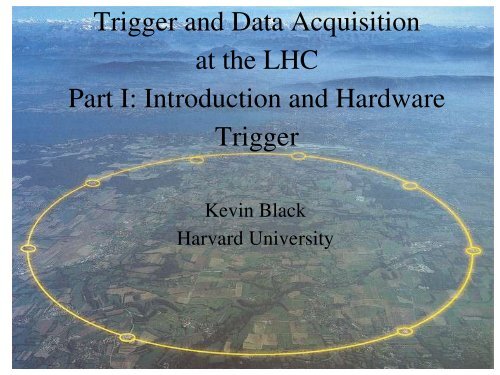Trigger and Data Acquisition at the LHC Part I: Introduction and ...
Trigger and Data Acquisition at the LHC Part I: Introduction and ...
Trigger and Data Acquisition at the LHC Part I: Introduction and ...
Create successful ePaper yourself
Turn your PDF publications into a flip-book with our unique Google optimized e-Paper software.
<strong>Trigger</strong> <strong>and</strong> <strong>D<strong>at</strong>a</strong> <strong>Acquisition</strong><br />
<strong>at</strong> <strong>the</strong> <strong>LHC</strong><br />
<strong>Part</strong> I: <strong>Introduction</strong> <strong>and</strong> Hardware<br />
<strong>Trigger</strong><br />
Kevin Black<br />
Harvard University
Outline<br />
●<br />
<strong>Introduction</strong><br />
– General Concepts<br />
– <strong>LHC</strong> Requirements<br />
– General <strong>Trigger</strong> Architecture<br />
●<br />
Implement<strong>at</strong>ions of 'Level 1' <strong>Trigger</strong>s <strong>at</strong> <strong>the</strong> <strong>LHC</strong><br />
– ATLAS + CMS Architecture<br />
– Examples
Basics<br />
●<br />
●<br />
●<br />
●<br />
<strong>LHC</strong> will collide protons<br />
<strong>at</strong> a center of mass energy<br />
of 14 TeV<br />
Collision R<strong>at</strong>e of 40 MHZ<br />
Most 'Interesting' physics<br />
doesn't happen <strong>at</strong> such a<br />
high r<strong>at</strong>e<br />
Even if we wanted to ,<br />
technological + $$<br />
limit<strong>at</strong>ions to ~200 Hz
●<br />
●<br />
●<br />
●<br />
●<br />
●<br />
Inelastic CrossSection is<br />
~70mb<br />
'Interesting' Physics on <strong>the</strong><br />
order of a few nb<br />
'Discovery' Physics on <strong>the</strong><br />
order of pb or even fb<br />
Cannot (<strong>and</strong> probably do not)<br />
want to record every beam<br />
crossing<br />
Need to make choices<br />
defining 'interesting'<br />
99.99%+ of <strong>the</strong>se choices are<br />
made very quickly (within<br />
microseconds) <strong>and</strong>
Generic <strong>Trigger</strong> Requirements<br />
<strong>and</strong> Challenges<br />
●<br />
●<br />
Highly Efficient on <strong>the</strong> very rare processes th<strong>at</strong> we wish to record<br />
Large Reduction of r<strong>at</strong>e<br />
– Higher r<strong>at</strong>e 'less interesting' processes<br />
– Instrumental Backgrounds<br />
●<br />
●<br />
●<br />
●<br />
High Processing R<strong>at</strong>e<br />
Large number of channels ~ 0.1 – few billion<br />
Push out 100 Mb/s to disk<br />
Not all detectors have d<strong>at</strong>a available in 25 ns (some take more<br />
than 10 times this)<br />
●<br />
Do all of <strong>the</strong> above in simultaneously with a finite amount of $$<br />
<strong>and</strong> time...
●<br />
●<br />
●<br />
●<br />
Beam is not continuous<br />
but comes in 'bunches'<br />
with very specific (<strong>and</strong><br />
complic<strong>at</strong>ed) structure<br />
25 ns between each<br />
'bucket' (where <strong>the</strong>re<br />
could be beam)<br />
2808 bunches organized<br />
in superbunches<br />
Acceler<strong>at</strong>or clock used to<br />
synchronize detectors<br />
<strong>LHC</strong> Basics
<strong>Trigger</strong> 101<br />
●<br />
Need to examine (nearly)<br />
every bunch crossing<br />
●<br />
– select most interesting<br />
ones<br />
– collect all detector<br />
output, transfer from<br />
detector frontend to<br />
tape<br />
But, not all d<strong>at</strong>a will be<br />
available in 25 ns, T()<br />
gets evalu<strong>at</strong>ed piece wise
I will talk<br />
about this one<br />
The Multilevel <strong>Trigger</strong><br />
●<br />
Level 1<br />
– Rapid rejection of most events<br />
in custom based hardware<br />
– short deadtime <strong>and</strong> fixed<br />
l<strong>at</strong>ency<br />
– examine every beam crossing<br />
●<br />
High Level <strong>Trigger</strong><br />
– more complex algorithms run<br />
on cpus which make final<br />
decisions<br />
●<br />
Key – buffer events during <strong>the</strong><br />
process r<strong>at</strong>her than fully<br />
processing one <strong>at</strong> a time
Pipelines<br />
●<br />
●<br />
●<br />
Events come every 25ns<br />
However, it takes >> 25ns to decide<br />
if event is worth recording or not<br />
Introduce pipelined system<br />
– <strong>Trigger</strong> decision must be made<br />
every 25ns, but <strong>the</strong> decision<br />
time can be longer (if you<br />
processing many events in<br />
parallel)<br />
●<br />
●<br />
trigger l<strong>at</strong>ency amount of time you<br />
have to make trigger decision +<br />
amount of time to move d<strong>at</strong>a around<br />
trigger l<strong>at</strong>ency FIXED <strong>at</strong> LVL1<br />
~3 microseconds <strong>at</strong> CMS/ATLAS
How to process
Deadtime<br />
●<br />
Deadtime – Fraction of<br />
total time th<strong>at</strong> <strong>the</strong><br />
detector is not live due to<br />
various reasons<br />
– some time period<br />
after trigger accept<br />
where detector is<br />
readout (unavoidable)<br />
– start/stop runs,<br />
failures
How does this compare to previous<br />
experiments
Overall <strong>Trigger</strong> Architecture<br />
CMS<br />
ATLAS<br />
Similar, CMS has 2 levels<br />
while ATLAS has 3
No Unique Solution ...<br />
With 3 level system – ATLAS reduces <strong>the</strong> load on readout<br />
but less flexible since only ROI are available <strong>at</strong> LVL2
Divide <strong>and</strong> Conquer<br />
●<br />
Global LVL1 <strong>Trigger</strong><br />
Processor fed by<br />
– Calorimeter LVL1 <strong>Trigger</strong><br />
Processor<br />
– Muon LVL1 <strong>Trigger</strong><br />
Processor<br />
●<br />
In turn, Muon <strong>and</strong> Calorimeter<br />
<strong>Trigger</strong>s are <strong>the</strong> sum of:<br />
– many calorimeter towers<br />
– local muon ASICS<br />
ATLAS LVL1 Example...
Which Detectors to use <strong>at</strong> L1
Why not Inner Detector Tracking <strong>at</strong><br />
L1 <strong>at</strong> <strong>the</strong> <strong>LHC</strong><br />
●<br />
●<br />
●<br />
●<br />
●<br />
High multiplicity, time<br />
consuming<br />
Huge number of channels<br />
Need to link up to o<strong>the</strong>r<br />
detector elements<br />
Technology <strong>at</strong> time of design<br />
<strong>and</strong> development just not fast<br />
enough<br />
Some sort of hardware trigger<br />
will be for an upgrade (though<br />
not <strong>at</strong> L1, but <strong>LHC</strong> is a 20<br />
year program..)
Regions of Interest (ROI) ATLAS<br />
●<br />
●<br />
●<br />
●<br />
Identify Regions based on<br />
local areas of activity <strong>at</strong><br />
LVL1 <strong>and</strong> pass on to HLT<br />
Based on course, fast<br />
inform<strong>at</strong>ion<br />
Reduces stress on HLT<br />
Only ROI d<strong>at</strong>a readout to<br />
first part of HLT
to ROI or not to ROI<br />
●<br />
●<br />
●<br />
●<br />
Reduces output to first part<br />
of HLT to 1% of total<br />
Smaller Readout networks<br />
More complic<strong>at</strong>ed scheme<br />
At LVL1 logical OR of all<br />
trigger sectors (<strong>the</strong>y are all<br />
independent!)<br />
●<br />
●<br />
●<br />
●<br />
High throughput<br />
Large readout<br />
networks<br />
Simpler scheme<br />
More flexible, but<br />
more dem<strong>and</strong>ing<br />
requirements
Example #1<br />
ATLAS Muon <strong>Trigger</strong><br />
●<br />
●<br />
●<br />
3 super layers in a toroid<br />
field, identify <strong>and</strong><br />
measure momenta<br />
Precision drift tubes for<br />
precise track<br />
reconstruction<br />
Fast 'Resistive Pl<strong>at</strong>e<br />
Chambers', <strong>and</strong> 'Thin Gap<br />
Chambers' for trigger
Remove overlap, tabul<strong>at</strong>e<br />
inform<strong>at</strong>ion for central<br />
trigger processor<br />
muon central<br />
processor<br />
regional processors<br />
readout, control,<br />
LVL2
ATLAS MIOCT Board
Muon <strong>Trigger</strong> Efficiency<br />
<strong>and</strong> R<strong>at</strong>es<br />
ATLAS<br />
ATLAS
Example #2<br />
CMS Jet <strong>Trigger</strong><br />
●<br />
●<br />
●<br />
●<br />
Ubiquitous <strong>at</strong> <strong>the</strong> <strong>LHC</strong><br />
Complic<strong>at</strong>ed objects ,<br />
composed of many<br />
(different types) of<br />
particles<br />
Calibr<strong>at</strong>ion, energy scale,<br />
need to control r<strong>at</strong>e<br />
Need not to split jets (<strong>and</strong><br />
overcount)
CMS Calorimeter Towers<br />
η<br />
ϕ<br />
η<br />
η<br />
ϕ<br />
η
Sliding Window Algorithm<br />
HCAL<br />
ECAL<br />
PbWO4<br />
crystal<br />
<strong>Trigger</strong> tower<br />
4x4 trigger towers = region<br />
Search for jets with a<br />
sliding 3x3 regions window<br />
Jet = 3x3 region where <strong>the</strong><br />
E T<br />
in <strong>the</strong> central region is<br />
above some threshold <strong>and</strong><br />
is bigger than <strong>the</strong> E T<br />
in any<br />
of <strong>the</strong> 8 outer regions<br />
<br />
A jet = 144 trigger towers, with typical tower dimensions ∆η x ∆φ = 0.09 x 0.09<br />
Hence typical jet dimensions: ∆η x ∆φ = 1 x 1
Regional Calorimeter <strong>Trigger</strong><br />
Receiver Card: Electron Isol<strong>at</strong>ion & Clock: Jet/Summary:<br />
Bar<br />
Front<br />
Adder<br />
Code<br />
mezz<br />
link<br />
cards<br />
DC-DC<br />
EISO<br />
EISO<br />
Input<br />
EISO<br />
SORT<br />
ASICs<br />
(w/he<strong>at</strong><br />
sinks)<br />
Receiver<br />
Mezz. Card<br />
BSCAN<br />
ASICs<br />
Front<br />
Back<br />
Bar Code<br />
Oscill<strong>at</strong>or<br />
Phase<br />
ASIC<br />
BSCAN<br />
ASICs<br />
PHASE<br />
ASICs<br />
MLUs<br />
Clock<br />
Input<br />
Clock<br />
delay<br />
adjust<br />
Clock<br />
DC-DC<br />
Converters<br />
Sort<br />
ASICs<br />
Back<br />
BSCAN<br />
ASICs
Expected R<strong>at</strong>es<br />
Η<br />
b<br />
b<br />
Would like to trigger on events<br />
like this.. but r<strong>at</strong>e explodes <strong>at</strong><br />
<strong>at</strong> low pT
Of Strawman <strong>and</strong> Real Menus<br />
●<br />
Tev<strong>at</strong>ron Experience<br />
– Initial <strong>Trigger</strong> Tables rel<strong>at</strong>ively simple > over 600<br />
triggers (including calibr<strong>at</strong>ion triggers, different<br />
luminosity settings, ...)<br />
– Detailed R<strong>at</strong>e Studies done on monte carlo are often<br />
drastically (by factor of 101000!) wrong.<br />
– Real b<strong>and</strong>width is often < than on paper b<strong>and</strong>width<br />
●<br />
Real work is preparing for different scenarios, not evalu<strong>at</strong>ing<br />
MC trigger efficiency to 0.001% (you can't trust monte carlo<br />
simul<strong>at</strong>ions to th<strong>at</strong> level!)
Conclusions<br />
●<br />
●<br />
<strong>Trigger</strong>ing <strong>at</strong> <strong>the</strong> <strong>LHC</strong> is complic<strong>at</strong>ed<br />
No unique solution, though generically split into<br />
– Fast electronics in custom hardware for fast rejection<br />
– Offline or close to offline reconstruction for HLT<br />
●<br />
Extremely important <strong>and</strong> contentious topic<br />
– most event selection takes place <strong>at</strong> LVL1<br />
●<br />
– physics priorities decide which events you will see for<br />
your analysis <strong>and</strong> which you won't<br />
DAQ <strong>and</strong> HLT to follow...

















